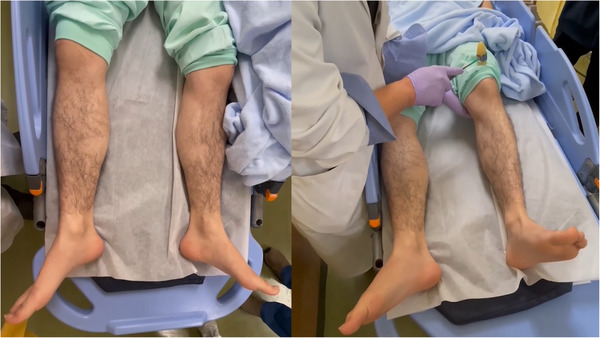1. PATIENT PRESENTATION
A 27‐year‐old male presented with sudden involuntary limb movements. His histories were unremarkable. Recently diagnosed with depression, he began taking escitalopram, a selective serotonin reuptake inhibitor (SSRI). The involuntary movements of the extremities developed and progressed. On admission, his vital signs were normal. On physical examination, ocular clonus, increased tendon reflexes, and myoclonus in the lower extremities were observed (Figure 1 and Video 1). Routine tests and head computed tomography were normal.
FIGURE 1.

Increased tendon reflexes in serotonin syndrome.
VIDEO 1.
Ocular clonus increased tendon reflexes and myoclonus of the lower extremities in serotonin syndrome.
2. DIAGNOSIS
2.1. Serotonin syndrome
The patient was urgently admitted for serotonin syndrome; symptoms resolved after stopping escitalopram, and the patient was discharged the next day.
Serotonin syndrome is a potentially fatal side effect of serotonin receptor agonists, including SSRIs. The principal symptoms include altered mental status, increased autonomic nervous system activity, and increased neuromuscular activity. 1 Mason et al 2 reported that 20%–40% of serotonin syndrome cases showed stable consciousness. Tachycardia occurred in 44% and hyperthermia occurred in 27%–34%. There are 3 diagnostic criteria for serotonin syndrome: Sternbach, Radomski, and Hunter criteria, with Hunter's criteria being used primarily. 2 Myoclonus occurs in 48.8% of patients, predominantly in the lower extremities, and hyperreflexia in 41% of patients. 1 , 3 These 2 physical findings are included in all 3 diagnostic criteria, 2 with ocular clonus included only in Hunter's criteria. 2 , 4 Although the frequency of ocular clonus is unknown, it is considered the most important diagnostic finding. 4 Serotonin syndrome does not have specific tests; its diagnosis relies on a detailed medical history and clinical judgment derived from physical and neurological examinations. Nonetheless, ocular clonus can be a diagnostic clue.
ACKNOWLEDGMENTS
We thank SoGoShinRyo brothers for movie editing and Editage (www.editage.jp) for English language editing.
Yoshidome AI, Yamasato K, Harada T, Ozawa H, Inoue T, Nakai M. Ocular clonus. JACEP Open. 2023;4:e13055. 10.1002/emp2.13055
Funding and support: By JACEP Open policy, all authors are required to disclose any and all commercial, financial, and other relationships in any way related to the subject of this article as per ICMJE conflict of interest guidelines (see www.icmje.org).
REFERENCES
- 1. Boyer EW, Shannon M. The serotonin syndrome. N Engl J Med. 2005;352(17):1112‐1120. doi: 10.1056/nejmra041867 [DOI] [PubMed] [Google Scholar]
- 2. Werneke U, Jamshidi F, Taylor DM, et al. Conundrums in neurology: diagnosing serotonin syndrome—a meta‐analysis of cases. BMC Neurol. 2016;16:97. doi: 10.1186/s12883-016-0616-1 [DOI] [PMC free article] [PubMed] [Google Scholar]
- 3. Mason PJ, Morris VA, Balcezak TJ. Serotonin syndrome. Presentation of 2 cases and review of the literature. Medicine. 2000;79(4):201‐209. doi: 10.1097/00005792-200007000-00001 [DOI] [PubMed] [Google Scholar]
- 4. Dunkley EJC, Isbister GK, Sibbritt D, et al. The hunter serotonin toxicity criteria: simple and accurate diagnostic decision rules for serotonin toxicity. QJM. 2003;96(9):635‐642. doi: 10.1093/qjmed/hcg109 [DOI] [PubMed] [Google Scholar]


